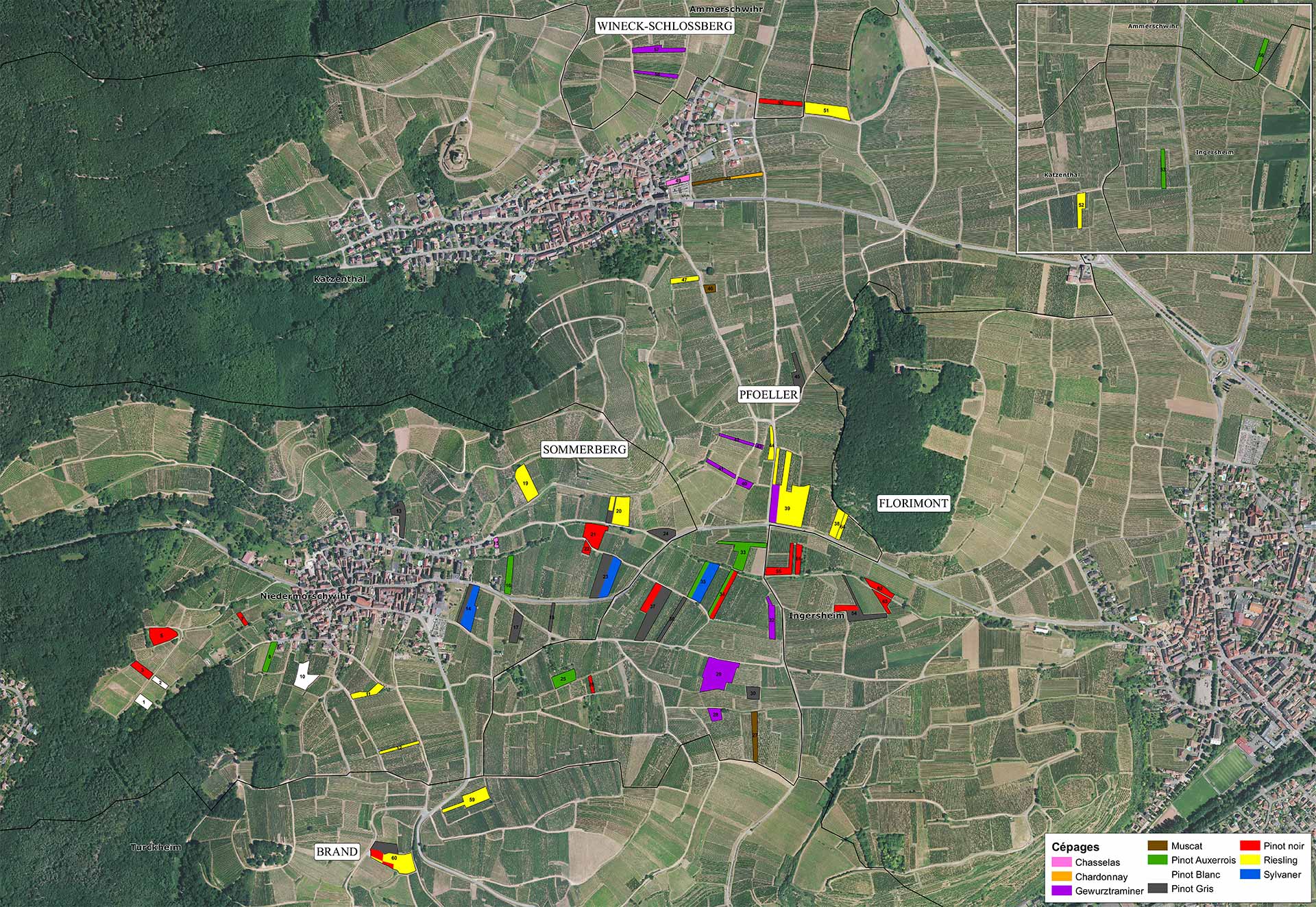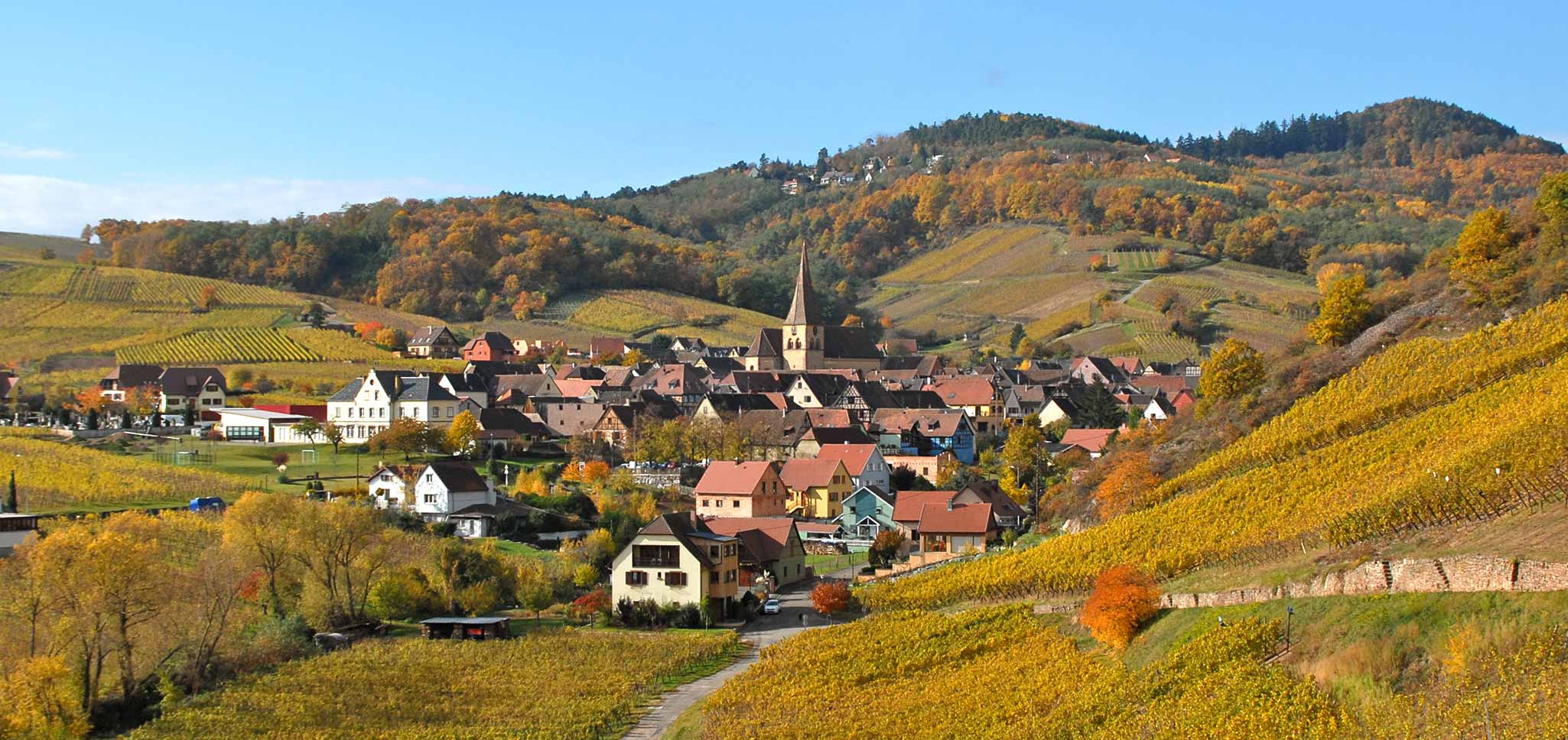
A l’écoute du Terroir
Since 1672, the Justin BOXLER family winery has been nestled in Niedermorschwihr, in the heart of the prestigious Alsace wine route, not far from the city of Colmar.
The family vineyard extends over 12 hectares spread over 5 communal banns. It is with a natural “organic” and respect for the specifications of organic farming, that the conversion has been carried out for 13 years. The estate is therefore certified (AB) with the 2022 vintage.
Charlotte and Florent inherit the first organic vintages.
The vineyard of the estate is divided between 5 communal bans. It is divided into 80 different plots within a radius of 8 kilometers from the property and the cellar.
Production takes place on 5 hectares in Katzenthal, 4.70 hectares in Niedermorschwihr, 1 hectare in Ingersheim, 0.80 hectares in Turckheim and 0.60 hectares in Ammerschwihr.
Niedermorschwihr is one of the smallest wine-growing areas in Alsace. It is therefore in Katzenthal, an adjoining village, that a large part of the surfaces are exploited. Katzenthal also represents the historical cradle of a branch of the Boxler family.

Anne and Pierre, line of Justin, have vinified the estate’s wines since the 1980 vintage.
After this period of evolution and transformation, Anne and Pierre pass on the baton to the 11th and new generation. It is therefore, on the basis of new ambitions and a promising youth, that Charlotte and Florent take on the responsibility of making the wines of tomorrow.
The first works target the modernity of certain technical itineraries as well as the promotion of new concepts and commercial horizons.
Florent joined the estate in 2015 following several years of professional experience with various Alsatian winegrowers. His mastery and his passion allow today to abound in cultural practices and guarantee the smooth passage of the Organic Agriculture certification.
Charlotte, after discovering the lands of Burgundy, Touraine and Germany, is preparing to conquer the imposing hillsides of Alsace.
The 2022 harvest, with many projects in progress, are the first juices and bubbles of the estate available in “AB”.
The village was known as Morswilre from 1148, a name appearing in a papal bull. Later, in the 16th century, the town was renamed Niedermorschwihr in order to distinguish it from Obermorschwihr which is near Eguisheim.
It belonged half to the Empire and half to the Habsburgs.

Niedermorschwihr est situé à l’ouest de Colmar, près de Turckheim, sur la route des Vins d’Alsace.
Le village est connu sous le nom de Morswilre dès 1148, nom apparu dans une bulle du pape. Plus tard, au XVIe siècle, la commune est renommée Niedermorschwihr afin de pouvoir la distinguer d’Obermorschwihr qui se trouve près d’Eguisheim. Elle appartenait pour moitié à l’Empire et pour moitié aux Habsbourg.
À cheval sur les bans d’Ammerschwihr, de Niedermorschwihr et de Turckheim se trouve la station climatique des Trois-Épis, abritant entre autres un centre d’altitude et de cure de repos. Autrefois ville du « Grand Hôtel », qui accueillait les touristes et autres curieux, la station perd peu à peu sa popularité et sombre dans l’oubli.
Les Trois-Épis sont nés d’un pèlerinage dédié à la Vierge et fondé en 1491 : en effet, la Vierge y serait apparue à un forgeron d’Orbey, tenant d’une main trois épis de blé, de l’autre un grêlon (augure d’une bonne ou d’une mauvaise récolte selon que les gens se convertiraient ou non). Le pèlerinage reprit rapidement, après avoir été interrompu par la guerre de Trente Ans. Un prieuré fondé en 1651 fut supprimé à la Révolution. Le pèlerinage cependant existe toujours.
Niedermorschwihr is located west of Colmar, near Turckheim, on the Alsace Wine Route.
The village was known as Morswilre from 1148, a name appearing in a papal bull. Later, in the 16th century, the town was renamed Niedermorschwihr in order to distinguish it from Obermorschwihr which is near Eguisheim. It belonged half to the Empire and half to the Habsburgs.
Straddling the banks of Ammerschwihr, Niedermorschwihr and Turckheim is the health resort of Trois-Épis, which houses, among other things, an altitude and rest cure centre. Formerly the city of the “Grand Hotel”, which welcomed tourists and other curious people, the resort is gradually losing its popularity and sinking into oblivion.
The Trois-Épis were born from a pilgrimage dedicated to the Virgin and founded in 1491: indeed, the Virgin would have appeared there to a blacksmith fromOrbey, holding three ears of wheat in one hand, a hailstone in the other (augurs a good or bad harvest depending on whether people convert or not). The pilgrimage resumed quickly, after having been interrupted by the Thirty Years’ War. A priory founded in 1651 was abolished during the Revolution. However, the pilgrimage still exists.
The Brand is located at the exit of the Munster valley, overlooking the town of Turckheim, this locality enjoys remarkable sunshine thanks to its southern and south-eastern exposure. it rises to an altitude of 380 m.
Resting on a granite substrate called Turckheim, with two micas, altered in arena, it offers a sandy and coarse soil.
The very homogeneous granitic nature and the excellent exposure of the terroir greatly favor the Riesling, the Pinot Gris and the Gewurztraminer, which here cover 57.95 ha.
On this “Tierra del Fuego” where legend has it that the sun fought a dragon, the famous wines of Turckheim, and the Brand in mind, have enjoyed an undisputed reputation since the Middle Ages. And if the dragon was forced to withdraw into a dark cave, the Brand shone throughout history in the firmament of the Grands Crus of Alsace. With great finesse, subtle, very particular fruitiness, the wines of the Grand Cru brand present a royal balance.
The Sommerberg extends at the foot of Trois-Epis, south of Katzenthal and north of Niedermorschwihr. Located on a very steep slope (45°), this locality faces south and rises to an altitude of nearly 400 m.
The granitic substrate with two micas, called Turckheim, in a very advanced state of disintegration, gives rise to these granitic arenas, rich in mineral elements, and so favorable to the cultivation of the vine. On the 28.36 ha of the locality, all the Alsatian grape varieties flourish wonderfully, and more particularly Riesling.
The Florimont is a protruding mound in the hills under the Vosges overlooking the town of Ingersheim.
It is a Bathonian and Bajocian limestone substrate covered below by conglomerates and Oligocene marls.
The Florimont draws the southern and eastern slopes, between 250 and 280 m above sea level. Its marl-limestone soils, relatively stony, prove to be eminently favorable to the cultivation of vines.
The Florimont, moreover, is located in the famous ellipse of Colmar where it benefits from quite privileged climatic conditions. Thanks to the protection of the highest peaks in the Vosges, the level of annual precipitation is indeed very low: around 550 mm.
Gewurztraminer is by far the most important grape variety of Florimont, which also reserves an excellent welcome on its 21 ha to Riesling, then to Muscat and Pinot Gris. The wine-growing town of Ingersheim enjoyed prosperity from the Middle Ages. It belonged to the seigniory of Hohlandsberg, feudal of the House of Austria. the Greats of the time, such as the Counts of Lupfen or Baron de Schwendi, a great benefactor of Alsatian viticulture, knew how to appreciate the wines of Florimont, and made it known.
The Grands Crus of Florimont are ample, balanced and of great longevity. These qualities have made them justly famous. The Gewurztraminer with spicy aromas is distinguished by its elegance and long persistence. the Riesling is particularly expressive and racy.
The Wineck-Schlossberg and its south and south-east facing slopes are located between 280 and 400 meters above sea level. The Schlossberg is a beautiful 27.40 ha vineyard on the banks of Katzenthal and Ammerschwihr.
These are highly disaggregated two-mica Turckheim granite soils. quite similar to their neighbours, the Grands Crus of Sommerberg in Niedermorschwihr and Brand in Turckheim. The situation of Katzenthal at the bottom of a valley closed on three sides and sheltered from the prevailing winds brings a particularly favorable microclimate giving with the quality of the soils, optimal conditions for the production of exceptional wines.
Wineck-Schlossberg is first and foremost the land of the king of Alsatian wines, Riesling, which develops all its qualities there. the Gewurztraminer also flourishes there remarkably. If the name of Schlossberg appears for the first time in documents from 1706, it is more than 700 years ago, in 1264, that we find the first written trace of Katzenthal wine. the plan of the ban d’Ingersheim et de Katzenthal, drawn up in 1760, shows around the Château du Wineck a vast area of vines, the “Schlossberg”, whose mentions have multiplied since the end of the 18th century and testify to its reputation.
The castle of Wineck dominates the vineyard of Katzenthal. Since the 12th century, it has been the only castle in Alsace entirely surrounded by vineyards. The Grands Crus of Wineck-Schlossberg are typical, racy wines, very characteristic of the best Alsace wines can have. The nature of the soils gives them their fruitiness, their aromas, their incomparable floral character.


I certify that I am of legal drinking age
in my country of residence